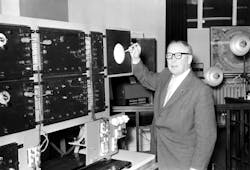Next-Generation Radar Data Management for Military Aviation
February 26, 2025 - Next-Generation Radar Data Management for Military Aviation
Introduction
Today marks an important anniversary in the history of radar. On February 26, 1935, Sir Robert Watson-Watt and his assistant, Arnold Wilkins, successfully demonstrated radar for the first time. Conducting an experiment near Daventry, England, they detected a Handley Page Heyford bomber using radio waves. This milestone proved that radar could detect aircraft at a distance, laying the foundation for the development of radar technology that became crucial in World War II and beyond.
Since that first successful demonstration, radar technology has evolved into an essential capability across all military operations. From air defense and surveillance to electronic warfare and intelligence gathering, radar has become a cornerstone of military strategy. The United States Air Force (USAF) operates an extensive range of radar systems across its fleet, ensuring superior situational awareness, target acquisition, and tracking capabilities in contested environments.
USAF Radar Systems: Detection, Tracking, and Situational Awareness
Primary radars serve as the main detection and tracking systems for USAF aircraft. These radars provide air-to-air and air-to-ground situational awareness, target acquisition, and engagement capabilities. Below are some examples of radars utilized on popular platforms today, but this list is not all-inclusive.
A Solution for Radar Data Recording
The TuffServ 640 (TS 640) is a high-performance rugged data recorder designed for intensive Radar, EW/ISR, and EO/IR applications. It enables secure, high-capacity radar data recording while having enough performance available to support 3rd party or internally developed AI/ML analysis for mission-critical insights. The TS 640 is an entirely open architecture system that seamlessly integrates additional components based on customer needs as long as we can fit it into its form factor. Additionally, we provide a pre-STIG hardened Red Hat Enterprise Linux (RHEL) operating system, but customers have the flexibility to utilize our software, their own, or third-party applications to best suit their mission objectives.
We also provide the Ampex Common Compute Environment (ACCE), a data management software suite designed to optimize data acquisition, organization, and retrieval. While ACCE enhances system efficiency, customers are not required to use it and can opt for their own software solutions if preferred.
Key Features:
- Storage Capacity: Up to 300TB removable storage.
- Network Interfaces: Dual 10GbE Optical interfaces.
- Encryption Options: AES 256/FIPS 197, FIPS-140, CSfC.
- Data Throughput: 1,900 MB/s internal rate, NFS data rate.
- Environmental Compliance: MIL-STD-810, MIL-STD-461F, ruggedized for harsh conditions.
Radar Data Storage Capabilities
To provide a complete picture of the TS 640’s capabilities, we first consider the worst-case scenario: maximum radar resolution at full operational duration. This scenario represents the highest data generation possible, ensuring that our solution meets even the most demanding requirements.
For a Fighter AESA Radar such as the AN/APG-77 on the F-22 Raptor, which can theoretically generate up to around 10 Gbps of radar data:
- 10 Gbps = 1.25 GB/s
- TS 640 Max Write Speed = 1,900 MB/s (1.9 GB/s)
- TS 640 Storage Capacity = 300TB (300,000 GB)
Assuming the F-22’s radar is continuously generating data at 10 Gbps, the TS 640 could theoretically record: 158 minutes (2.6 hours) of continuous radar data at full resolution before reaching storage capacity.
For Surveillance Radars such as the AN/APY-2 on the E-3 Sentry, which should produce around 50 Gbps:
- 50 Gbps = 6.25 GB/s
- TS 640 Recording Time: 48 minutes before reaching full storage capacity.
A More Realistic Concept of Operations
Aircraft radars do not operate at full resolution for the entire mission. Instead, they adjust resolution, power consumption, and data rates based on mission priorities and operational constraints. In most cases, radars function between 10-70% of their maximum theoretical resolution to balance situational awareness, energy efficiency, and data management.
Estimated Operational Radar Data Rates
Fighter AESA Radar (Air-to-Air Tracking Mode)
- Maximum Resolution: 10 Gbps
- Typical Operational Resolution: 1-5 Gbps
- Estimated Data Rate: 100-500 Mbps per tracked target
- Total Radar Data Per Mission: 200 GB to 1 TB
Synthetic Aperture Radar (Air-to-Ground Imaging Mode)
- Maximum Resolution: 5-10 Gbps (varies by operational mode and environmental conditions)
- Typical Operational Resolution: 0.3-3 meters
- Estimated Data Rate: 50 Mbps to 1 Gbps
- Total Data Per Imaging Session: 50 GB per minute
AEW&C Surveillance Radar (Long-Range Multi-Target Tracking)
- Maximum Resolution: 50 Gbps
- Typical Operational Use: 15-35 Gbps
- Estimated Data Rate: 100 Mbps to 1 Gbps
- Total Mission Data: Estimated between 5-15 TBs depending on operational factors such as number of tracked targets, mission duration, and radar mode utilization
